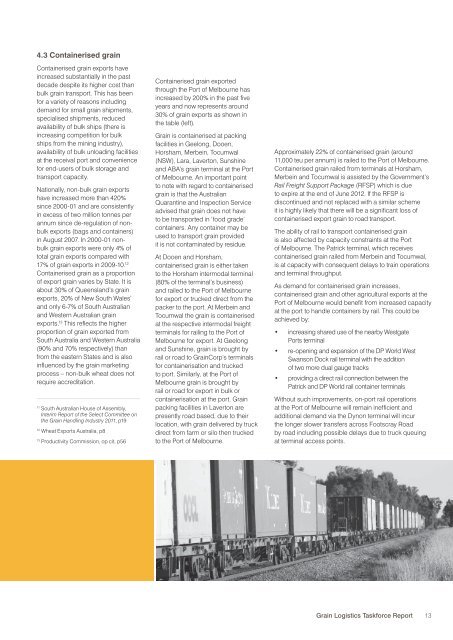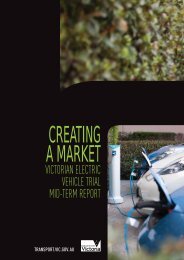Grain Logistics Taskforce Report - Department of Transport
Grain Logistics Taskforce Report - Department of Transport
Grain Logistics Taskforce Report - Department of Transport
Create successful ePaper yourself
Turn your PDF publications into a flip-book with our unique Google optimized e-Paper software.
4.3 Containerised grainContainerised grain exports haveincreased substantially in the pastdecade despite its higher cost thanbulk grain transport. This has beenfor a variety <strong>of</strong> reasons includingdemand for small grain shipments,specialised shipments, reducedavailability <strong>of</strong> bulk ships (there isincreasing competition for bulkships from the mining industry),availability <strong>of</strong> bulk unloading facilitiesat the receival port and conveniencefor end-users <strong>of</strong> bulk storage andtransport capacity.Nationally, non-bulk grain exportshave increased more than 420%since 2000-01 and are consistentlyin excess <strong>of</strong> two million tonnes perannum since de-regulation <strong>of</strong> nonbulkexports (bags and containers)in August 2007. In 2000-01 nonbulkgrain exports were only 4% <strong>of</strong>total grain exports compared with17% <strong>of</strong> grain exports in 2009-10. 12Containerised grain as a proportion<strong>of</strong> export grain varies by State. It isabout 30% <strong>of</strong> Queensland’s grainexports, 20% <strong>of</strong> New South Wales’and only 6-7% <strong>of</strong> South Australianand Western Australian grainexports. 13 This refl ects the higherproportion <strong>of</strong> grain exported fromSouth Australia and Western Australia(90% and 70% respectively) thanfrom the eastern States and is alsoinfl uenced by the grain marketingprocess – non-bulk wheat does notrequire accreditation.11South Australian House <strong>of</strong> Assembly,Interim <strong>Report</strong> <strong>of</strong> the Select Committee onthe <strong>Grain</strong> Handling Industry 2011, p1912Wheat Exports Australia, p813Productivity Commission, op cit, p56Containerised grain exportedthrough the Port <strong>of</strong> Melbourne hasincreased by 200% in the past fi veyears and now represents around30% <strong>of</strong> grain exports as shown inthe table (left).<strong>Grain</strong> is containerised at packingfacilities in Geelong, Dooen,Horsham, Merbein, Tocumwal(NSW), Lara, Laverton, Sunshineand ABA’s grain terminal at the Port<strong>of</strong> Melbourne. An important pointto note with regard to containerisedgrain is that the AustralianQuarantine and Inspection Serviceadvised that grain does not haveto be transported in ‘food grade’containers. Any container may beused to transport grain providedit is not contaminated by residue.At Dooen and Horsham,containerised grain is either takento the Horsham intermodal terminal(80% <strong>of</strong> the terminal’s business)and railed to the Port <strong>of</strong> Melbournefor export or trucked direct from thepacker to the port. At Merbein andTocumwal the grain is containerisedat the respective intermodal freightterminals for railing to the Port <strong>of</strong>Melbourne for export. At Geelongand Sunshine, grain is brought byrail or road to <strong>Grain</strong>Corp’s terminalsfor containerisation and truckedto port. Similarly, at the Port <strong>of</strong>Melbourne grain is brought byrail or road for export in bulk orcontainerisation at the port. <strong>Grain</strong>packing facilities in Laverton arepresently road based, due to theirlocation, with grain delivered by truckdirect from farm or silo then truckedto the Port <strong>of</strong> Melbourne.Approximately 22% <strong>of</strong> containerised grain (around11,000 teu per annum) is railed to the Port <strong>of</strong> Melbourne.Containerised grain railed from terminals at Horsham,Merbein and Tocumwal is assisted by the Government’sRail Freight Support Package (RFSP) which is dueto expire at the end <strong>of</strong> June 2012. If the RFSP isdiscontinued and not replaced with a similar schemeit is highly likely that there will be a signifi cant loss <strong>of</strong>containerised export grain to road transport.The ability <strong>of</strong> rail to transport containerised grainis also affected by capacity constraints at the Port<strong>of</strong> Melbourne. The Patrick terminal, which receivescontainerised grain railed from Merbein and Tocumwal,is at capacity with consequent delays to train operationsand terminal throughput.As demand for containerised grain increases,containerised grain and other agricultural exports at thePort <strong>of</strong> Melbourne would benefi t from increased capacityat the port to handle containers by rail. This could beachieved by:• increasing shared use <strong>of</strong> the nearby WestgatePorts terminal• re-opening and expansion <strong>of</strong> the DP World WestSwanson Dock rail terminal with the addition<strong>of</strong> two more dual gauge tracks• providing a direct rail connection between thePatrick and DP World rail container terminalsWithout such improvements, on-port rail operationsat the Port <strong>of</strong> Melbourne will remain ineffi cient andadditional demand via the Dynon terminal will incurthe longer slower transfers across Footscray Roadby road including possible delays due to truck queuingat terminal access points.<strong>Grain</strong> <strong>Logistics</strong> <strong>Taskforce</strong> <strong>Report</strong> 13
















